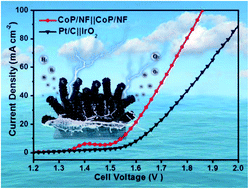Metal–organic framework-derived hierarchical ultrathin CoP nanosheets for overall water splitting†
Abstract
Hydrogen generation through electrochemical water splitting plays a significant role in solving the energy crisis and preventing the rapid depletion of fossil fuels, and requires efficient and robust electrocatalysts for both the hydrogen and oxygen evolution reactions (HER & OER). Transition-metal phosphides with a similar structure to the hydrogenase enzyme are emerging as promising electrocatalysts for the HER, but their catalytic activity for overall water splitting is kinetically retarded. Herein, a facile and effective strategy is provided for fabricating hierarchical porous nanorods composed of ultrathin CoP nanosheets on nickel foam (NF) by direct phosphidation of MOF-derived Co(OH)2 nanosheets. The unique porous and ultrathin nanosheet structure endows the resulting catalyst with abundant exposed active sites and boundary defects, short ion diffusion paths, and improved conductivity, which are favorable for improving its catalytic performance. Consequently, the hierarchical CoP/NF electrode shows highly efficient electrocatalytic activity with long-term durability for the HER under universal-pH conditions. Surprisingly, the CoP/NF also displays superior OER performance in alkaline solutions. Furthermore, the practical application of CoP/NF as a bifunctional catalyst for the overall water splitting reaction yields a low cell voltage of only 1.54 V to reach a current density of 10 mA cm−2, much better than those for many reported bifunctional catalysts.

- This article is part of the themed collection: Journal of Materials Chemistry A HOT Papers


 Please wait while we load your content...
Please wait while we load your content...